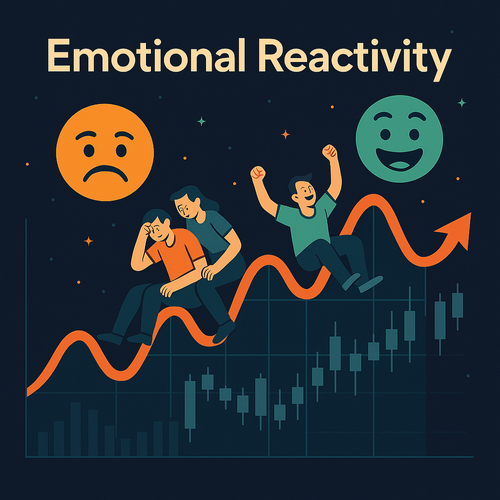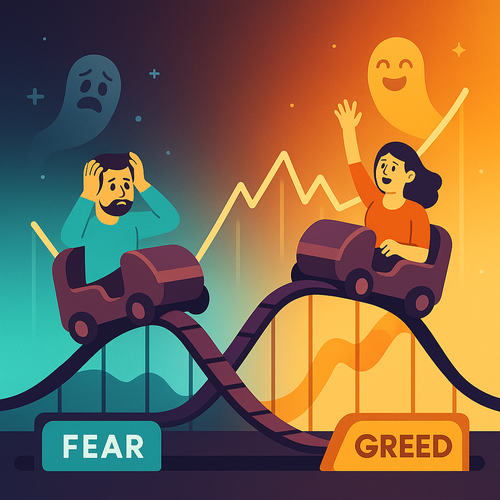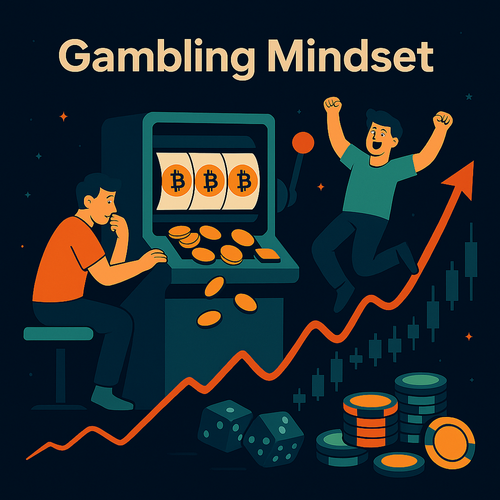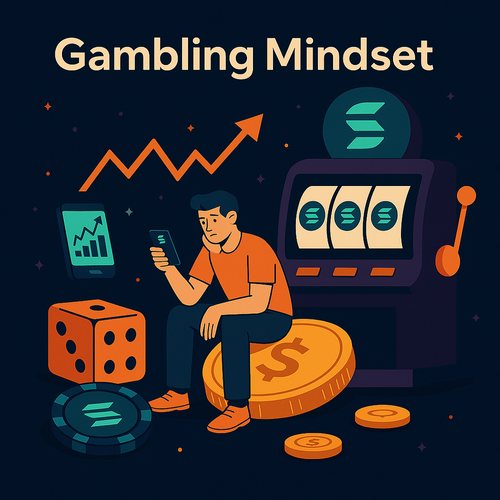Mastering What NOT to Do in Crypto Markets - Part I
Mastering What NOT to Do in Crypto Markets
Entering the crypto market, new investors are typically eager to learn what to do – which coins to buy, when to trade, how to find the next big opportunity. Yet the first and most crucial lessons are often about what not to do. The truth is that avoiding major mistakes and emotional traps sets the foundation for any successful investing strategy. Crypto and DeFi markets are highly volatile and psychologically taxing, making it easy for beginners (and even experienced traders) to fall into classic behavioral pitfalls.
“Emotional cycles often lead investors to “buy high, sell low.” Avoiding that fate is key to long-term success.”
Below, we explore five of the most common psychological traps – and how to recognize and mitigate them – so you can safeguard your wealth and sanity in the digital asset arena.
“Emotional cycles often lead investors to “buy high, sell low.” Avoiding that fate is key to long-term success.”
Below, we explore five of the most common psychological traps – and how to recognize and mitigate them – so you can safeguard your wealth and sanity in the digital asset arena.


1. Emotional Reactivity: The Fear & Greed Rollercoaster
Crypto markets run on a high-octane mix of fear and euphoria, often swinging wildly and triggering knee-jerk reactions. Emotional reactivity is the tendency to make snap investment decisions based on pain or excitement – for example, panic-selling in a crash or FOMO-buying during a hype rally. This trap causes countless investors to buy high and sell low, the exact opposite of a sound strategy.
Real-world example: In the 2021 bull run, many newcomers watched Bitcoin and other coins skyrocket and rushed in near all-time highs, driven by the fear of missing out (FOMO). Months later, when prices plunged in the inevitable correction, those same investors panic-sold at the bottom – locking in huge losses. This pattern isn’t new. During past crashes like 2008 or the March 2020 COVID plunge, investors who dumped their holdings in terror “sold at precisely the wrong moment,” only to see markets recover soon after. Those who kept their cool – or even bought during the fear – were the ones who reaped substantial gains in the recovery.
Why it happens: When faced with sharp losses, our brains experience loss aversion – the pain of losses hurts far more than the pleasure of gains. This pain, combined with herd mentality (seeing everyone else sell or buy), can overwhelm logic. Likewise, surging prices create euphoric excitement that makes us forget risks. Emotionally charged news and social media only amplify this, fueling a cycle of greed and fear. An investor might feel invincible during a rally or doomed during a dip, leading to impulsive moves divorced from any real analysis.
How to avoid reactive trades: Develop habits to pause and reflect instead of immediately reacting to price swings. Have a pre-defined plan for downturns (e.g. “If my coin drops 30%, I’ll reassess rather than sell in panic”) and for euphoric times (“I will take partial profits” or “stick to my allocation” when everyone else is piling in). Some practical tips:
By training yourself to respond calmly rather than react reflexively, you’ll avoid the worst financial injuries caused by fear and greed. Remember that emotional investing is one of the greatest threats to financial success and can set off a ruinous cycle of “selling during downturns, then re-entering during rallies,” over and over. Breaking that cycle early on is critical.
Real-world example: In the 2021 bull run, many newcomers watched Bitcoin and other coins skyrocket and rushed in near all-time highs, driven by the fear of missing out (FOMO). Months later, when prices plunged in the inevitable correction, those same investors panic-sold at the bottom – locking in huge losses. This pattern isn’t new. During past crashes like 2008 or the March 2020 COVID plunge, investors who dumped their holdings in terror “sold at precisely the wrong moment,” only to see markets recover soon after. Those who kept their cool – or even bought during the fear – were the ones who reaped substantial gains in the recovery.
Why it happens: When faced with sharp losses, our brains experience loss aversion – the pain of losses hurts far more than the pleasure of gains. This pain, combined with herd mentality (seeing everyone else sell or buy), can overwhelm logic. Likewise, surging prices create euphoric excitement that makes us forget risks. Emotionally charged news and social media only amplify this, fueling a cycle of greed and fear. An investor might feel invincible during a rally or doomed during a dip, leading to impulsive moves divorced from any real analysis.
How to avoid reactive trades: Develop habits to pause and reflect instead of immediately reacting to price swings. Have a pre-defined plan for downturns (e.g. “If my coin drops 30%, I’ll reassess rather than sell in panic”) and for euphoric times (“I will take partial profits” or “stick to my allocation” when everyone else is piling in). Some practical tips:
- Zoom Out: In moments of fear or FOMO, zoom out to the bigger picture. Remind yourself that markets move in cycles and downturns are usually followed by recoveries. Don’t let short-term volatility hijack a sound long-term thesis.
- Check Your Emotions: Notice physical and mental cues – a racing heartbeat, anxious urge to hit “sell,” or giddy temptation to double down. These are signs you’re trading on emotion. Step away or wait a set 24 hours before taking action on any drastic decision.
- Stick to Strategy: If you have a target allocation or a research-backed conviction, trust that more than the mood of the moment. For example, if your analysis says a token is fundamentally strong, don’t let a Twitter scare or hype article completely derail your plan. Execute your strategy (take profits, cut losses, rebalance) calmly according to predetermined rules, not gut panic.
By training yourself to respond calmly rather than react reflexively, you’ll avoid the worst financial injuries caused by fear and greed. Remember that emotional investing is one of the greatest threats to financial success and can set off a ruinous cycle of “selling during downturns, then re-entering during rallies,” over and over. Breaking that cycle early on is critical.
2. Low Impulse Control: Overtrading and Chasing Pumps
In crypto’s 24/7 casino-like environment, impulsivity is a silent portfolio killer. Low impulse control manifests as overtrading (excessive buying and selling) and chasing hot pumps without patience or strategy. Many beginners feel compelled to act on every price tick, every rumor, every “hot tip” – leading to frenzied short-term trading that often backfires. Simply put, making too many trades based on impulse rather than analysis is a recipe for burning up your capital and destroying the magic of compounding returns.
Why it happens: Overtrading is often driven by emotion – boredom, greed, or the illusion of missing out. A trader might score a couple of quick wins and grow overconfident, then start placing impulsive bets without proper research (the “I can’t lose” mindset). On the flip side, after a loss, some chase risky revenge trades to “make it back,” escalating into a spiral of bad decisions. Psychologically, it’s a dopamine chase: rapid trading gives a rush, like hitting the spin button on a slot machine. But this hyperactivity blurs the line between calculated investing and reckless gambling. It also feeds a false belief that more trades = more profit, when in reality each trade incurs fees/slippage and the odds of mistakes multiply. The result is often “compounding losses” instead of gains – a frantic trader who keeps scrambling ends up eroding their account rather than growing it.
Real-world example: Consider a DeFi day-trader who hops between new yield farms and tokens every other day. In pursuit of quick gains, they pay high transaction fees, sell winners too early, and hold losers too long hoping to break even. Transaction costs and small timing errors quietly eat away at any profits. Meanwhile, a patient investor who simply held a quality crypto asset for the same period might easily outperform the hyperactive trader. Studies have shown that frequent traders often significantly underperform the market precisely because of these factors – they churn their portfolio to death while missing out on the sustained growth that comes from a steadier approach.
The cure for impulsiveness: The antidote is learning that inaction is often more powerful than constant action. As the saying goes, “money is made by sitting, not trading.” Some practical ways to build discipline and patience:
Ultimately, successful investing is more marathon than sprint. By curbing the urge to “do something” all the time, you allow the power of compounding and well-timed opportunities to work in your favor. Fewer, smarter decisions trump a flurry of random moves.
Why it happens: Overtrading is often driven by emotion – boredom, greed, or the illusion of missing out. A trader might score a couple of quick wins and grow overconfident, then start placing impulsive bets without proper research (the “I can’t lose” mindset). On the flip side, after a loss, some chase risky revenge trades to “make it back,” escalating into a spiral of bad decisions. Psychologically, it’s a dopamine chase: rapid trading gives a rush, like hitting the spin button on a slot machine. But this hyperactivity blurs the line between calculated investing and reckless gambling. It also feeds a false belief that more trades = more profit, when in reality each trade incurs fees/slippage and the odds of mistakes multiply. The result is often “compounding losses” instead of gains – a frantic trader who keeps scrambling ends up eroding their account rather than growing it.
Real-world example: Consider a DeFi day-trader who hops between new yield farms and tokens every other day. In pursuit of quick gains, they pay high transaction fees, sell winners too early, and hold losers too long hoping to break even. Transaction costs and small timing errors quietly eat away at any profits. Meanwhile, a patient investor who simply held a quality crypto asset for the same period might easily outperform the hyperactive trader. Studies have shown that frequent traders often significantly underperform the market precisely because of these factors – they churn their portfolio to death while missing out on the sustained growth that comes from a steadier approach.
The cure for impulsiveness: The antidote is learning that inaction is often more powerful than constant action. As the saying goes, “money is made by sitting, not trading.” Some practical ways to build discipline and patience:
- Set a Trading Plan & Rules: Define your strategy in advance – what you buy, why, under what conditions you’ll sell, and how often you’ll allow yourself to trade. For example, limit active trades to X per week or require a 24-hour “cooldown” before acting on any new idea. Having structure makes you think twice before every knee-jerk trade.
- Focus on Quality over Quantity: Remind yourself that not every day is a trading day. It’s far better to take a few high-conviction, well-researched positions than dozens of scattershot bets. Each excessive trade you don’t make is a penny saved (in fees) and a mistake avoided. As one guide puts it, patience and discipline yield better results than frantic trading.
- Automate and Regularize: If you struggle with constant tinkering, consider automating parts of your investing. Techniques like dollar-cost averaging (DCA) – investing a fixed amount on a regular schedule – can enforce discipline and prevent impulsive all-in moves. Automation helps remove the emotional temptation to time every wiggle.
Ultimately, successful investing is more marathon than sprint. By curbing the urge to “do something” all the time, you allow the power of compounding and well-timed opportunities to work in your favor. Fewer, smarter decisions trump a flurry of random moves.
3. Gambling Mindset: Trading as Entertainment or Thrill
There’s a fine line between strategic trading and gambling – and many crypto participants unwittingly cross it. The gambling mindset is treating crypto like a casino: taking high-risk bets for the thrill, “YOLO”ing into sketchy tokens, or using extreme leverage with a lottery-ticket mentality. This trap is especially dangerous because the rush of gains (or the hope of them) can become addictive, leading to reckless behavior that resembles problem gambling.


Signs of a gambling approach: If you find yourself trading mainly for the adrenaline – constantly checking prices, bragging about lucky wins, doubling down on risky bets to “hit it big” – you may be in the gambling zone. Rather than analyzing investments on merit, gamblers go by hunches, hype, or pure hope. Losses are often met with denial or more risk-taking (chasing losses), much like a gambler at a roulette table. In the crypto world, the always-open, 24/7 market and tales of overnight millionaires only fuel this mindset.
Real-world examples: The 2021 meme coin frenzy saw many people throw money into tokens named after dogs or food (Dogecoin, Shiba Inu, etc.) purely for fun and speculation, not because of fundamentals. Some got lucky when prices mooned, but many chased these bets late and lost most of their stake – essentially paying for an expensive thrill. Similarly, high-leverage trading on futures exchanges gives a casino-like rush. A trader might leverage 100x trying to turn $1,000 into $100,000 in a single bet. It might work once by luck, but more often a few wrong moves wipe out the account. This behavior mirrors gambling: the uncertain outcome, the excitement of a big win, followed by despair of a loss. Neuroscience research shows that the dopamine hits from risky trades can mimic those from gambling or drugs, reinforcing the cycle of thrill-seeking even in the face of repeated losses.
How to keep speculation healthy: There’s nothing wrong with taking calculated risks – that’s part of investing – but you must approach it professionally, not like a slot machine. To avoid the gambling trap:
Above all, cultivate a mindset that trading is a business, not a game. The more you treat your portfolio like a casino, the more likely the house (the market) will eventually win. To achieve lasting wealth, focus on strategy and risk management over excitement. the itch without endangering your financial future.
Real-world examples: The 2021 meme coin frenzy saw many people throw money into tokens named after dogs or food (Dogecoin, Shiba Inu, etc.) purely for fun and speculation, not because of fundamentals. Some got lucky when prices mooned, but many chased these bets late and lost most of their stake – essentially paying for an expensive thrill. Similarly, high-leverage trading on futures exchanges gives a casino-like rush. A trader might leverage 100x trying to turn $1,000 into $100,000 in a single bet. It might work once by luck, but more often a few wrong moves wipe out the account. This behavior mirrors gambling: the uncertain outcome, the excitement of a big win, followed by despair of a loss. Neuroscience research shows that the dopamine hits from risky trades can mimic those from gambling or drugs, reinforcing the cycle of thrill-seeking even in the face of repeated losses.
How to keep speculation healthy: There’s nothing wrong with taking calculated risks – that’s part of investing – but you must approach it professionally, not like a slot machine. To avoid the gambling trap:
- Set Risk Limits: Never wager money you can’t afford to lose. Treat high-risk plays as highly speculative. Use position sizing (only a small % of your portfolio in any single risky bet) and consider setting strict loss limits (stop-loss orders or mental stop points). This ensures one wild bet can’t ruin you.
- Make Deliberate, Researched Bets: Before entering a trade, ask yourself if you can articulate a rational reason for it (fundamental value, clear trend, etc.) or if it’s just for excitement. For any coin or strategy, do at least basic research (what the project is, why it has value, what could go wrong). If you’re just betting because “others are doing it” or it feels like a thrill, pump the brakes.
- Channel the Thrill Elsewhere: If you genuinely enjoy the adrenaline of speculation, allocate a small “fun money” fund for controlled gambles (like 5% of your portfolio) and treat it as entertainment expense. Keep your core investments separate and managed with discipline. This way, you scratch the itch without endangering your financial future.
Above all, cultivate a mindset that trading is a business, not a game. The more you treat your portfolio like a casino, the more likely the house (the market) will eventually win. To achieve lasting wealth, focus on strategy and risk management over excitement. the itch without endangering your financial future.

